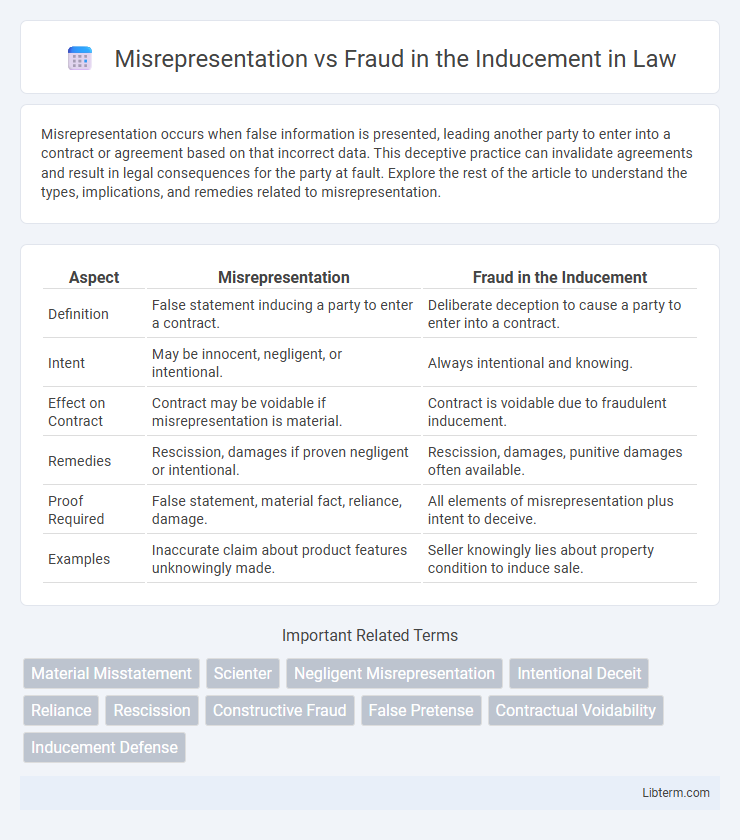Misrepresentation occurs when false information is presented, leading another party to enter into a contract or agreement based on that incorrect data. This deceptive practice can invalidate agreements and result in legal consequences for the party at fault. Explore the rest of the article to understand the types, implications, and remedies related to misrepresentation.
Table of Comparison
| Aspect | Misrepresentation | Fraud in the Inducement |
|---|---|---|
| Definition | False statement inducing a party to enter a contract. | Deliberate deception to cause a party to enter into a contract. |
| Intent | May be innocent, negligent, or intentional. | Always intentional and knowing. |
| Effect on Contract | Contract may be voidable if misrepresentation is material. | Contract is voidable due to fraudulent inducement. |
| Remedies | Rescission, damages if proven negligent or intentional. | Rescission, damages, punitive damages often available. |
| Proof Required | False statement, material fact, reliance, damage. | All elements of misrepresentation plus intent to deceive. |
| Examples | Inaccurate claim about product features unknowingly made. | Seller knowingly lies about property condition to induce sale. |
Understanding Misrepresentation: Key Concepts
Misrepresentation in the inducement involves false statements or omissions that lead one party to enter a contract without full understanding of the facts. Key concepts include the distinction between innocent, negligent, and fraudulent misrepresentation, each varying by the intent and knowledge of the falsehood. Establishing misrepresentation requires proving a false statement, reliance by the injured party, and resulting damages affecting their contractual decision.
Defining Fraud in the Inducement
Fraud in the inducement occurs when one party intentionally deceives another to enter into a contract by misrepresenting a material fact with the intent to mislead. This intentional deception must be proven to establish fraud, differentiating it from mere misrepresentation, which can be innocent or negligent. Courts require clear evidence of knowingly false statements made to induce agreement, impacting contract validity and remedies available.
Core Differences Between Misrepresentation and Fraud
Misrepresentation involves a false statement made without intent to deceive, whereas fraud in the inducement requires deliberate deception to persuade another party into a contract. The key difference lies in intent: misrepresentation may result from negligence or innocent error, while fraud entails knowing and intentional falsehoods. Remedies for fraud typically include rescission and damages due to the intentional harm caused, while misrepresentation may only allow for contract avoidance or modification.
Legal Elements of Misrepresentation
Misrepresentation in the inducement requires a false statement of material fact made knowingly or without belief in its truth, intended to induce another party's reliance, resulting in damages. The legal elements include a misstatement or omission, intent to deceive, justifiable reliance by the victim, and causation linking the misrepresentation to the harm suffered. Unlike fraud, which involves intentional deceit, misrepresentation may also cover negligent or innocent falsehoods affecting contract validity.
Essential Elements of Fraud in the Inducement
Fraud in the inducement requires essential elements including a false representation of a material fact, knowledge of its falsity by the party making it, intent to deceive the other party, justifiable reliance by the victim, and resulting damages. This intentional deception differs from mere misrepresentation, which may involve innocent or negligent inaccuracies without fraudulent intent. Understanding these elements is critical for establishing fraud in inducement claims in contract disputes.
Types of Misrepresentation (Innocent, Negligent, Fraudulent)
Misrepresentation in inducement includes innocent, negligent, and fraudulent types, each differing by the intent and knowledge of the false statement. Innocent misrepresentation occurs without intent to deceive, based on a genuine mistake of fact, while negligent misrepresentation arises from carelessness or failure to verify information properly. Fraudulent misrepresentation involves intentional deceit, where the party knowingly provides false information to induce the other party into a contract, leading to potential legal consequences such as rescission or damages.
Real-World Examples: Misrepresentation vs Fraud
Misrepresentation in inducement occurs when a false statement unintentionally leads a party to enter a contract, such as a seller mistakenly overstating a car's mileage. Fraud in inducement involves intentional deception, exemplified by a seller knowingly concealing defects to persuade the buyer, as seen in cases where real estate agents hide property damage. Courts often differentiate these based on intent, affecting remedies like contract rescission or damages for the injured party.
Legal Remedies and Consequences
Legal remedies for misrepresentation in the inducement typically include rescission of the contract and damages to restore the injured party to their original position. Fraud in the inducement, a deliberate deception, often leads to more severe consequences such as punitive damages and potential criminal liability. Courts distinguish between the two based on intent, influencing the scope and severity of legal outcomes available.
Proving Liability in Court
Proving liability in misrepresentation versus fraud in the inducement hinges on establishing the defendant's intent and the plaintiff's reliance on false information. In fraud cases, courts require clear evidence that the defendant knowingly made false statements to deceive the plaintiff, which directly caused harm. Misrepresentation claims may only need proof of negligent false statements, with the plaintiff demonstrating reasonable reliance and resulting damages.
Preventing Misrepresentation and Fraud in Contracts
Preventing misrepresentation and fraud in contracts involves thorough due diligence and clear disclosure of all material facts to ensure parties have accurate information. Implementing standardized verification processes, such as third-party audits and written confirmations, reduces the risk of false statements influencing contract formation. Establishing explicit contractual remedies and educating parties about legal consequences further deters fraudulent inducement and misrepresentations.
Misrepresentation Infographic

 libterm.com
libterm.com